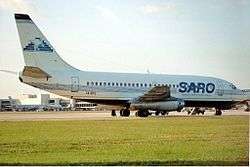SARO (airline)
|
A former SARO B737 at Miami International Airport in 1992 | |||||||
| |||||||
| Commenced operations | 1991 | ||||||
|---|---|---|---|---|---|---|---|
| Ceased operations | 1994 | ||||||
| Destinations | 18 | ||||||
| Headquarters | Monterrey, Mexico | ||||||
SARO (Servicios Aéreos Rutas Oriente) was an airline based in Monterrey, Mexico. The airline was established in 1991 and due to their low prices, was one of the first low-cost airlines in Mexico and America. It operated scheduled and charter flights to Mexico City. SARO ceased operations in 1994.
Airline motto
"Una Aerolínea con todo... para todos!" (means "An airline with everything... for everybody!") which depicted the "low-Fares" character of the airline, not common in Mexico at that time.
Difficulties and struggles
SARO was a good attempt at starting up a true low-cost domestic airline many years before the present ones. It was riddled with adverse conditions, unfair competition from the "official" airlines (Mexicana and Aeromexico both part of CINTRA, a government operation). It was born from private investors from Monterrey, Mexico. But the large cost of trying to operate a scheduled airline against all kind of difficulties, some placed by the established operators at the government owned CINTRA, some by the official fuel supplier and the governmental airport operators conglomerate (ASA), were just impossible to overcome. At the same time, many corners were cut, crews frequently included a variable experienced captain together with a very unexperienced co-pilot (in those years the concept of Pilot-Flying and Pilot-Assisting were not really applied), the captain was the only one truly at command, and the co-pilot was merely in his seat by requirement; almost all take-offs and landings were made by the captains. Training was limited and performed in an old-fashioned way by an experienced Chief of Pilots imparting practice on captains and first officers as well. Equipment was old and too often had been heavily used and abused by the previous, numerous owners. Maintenance was done at other countries because of lack of infrastructure in Mexico; it was a usual practice to carry one or two mechanics on board on most flights for routine maintenance (and frequent minor repairs), and some of those mechanics were from Mexicana and were working in their "spare time", due to their familiarity with old Boeing equipment.
Many times, the flights became more and more delayed for various reasons: lack of equipment due to maintenance or diverse failures, lack of fuel due to the small airline becoming indebted with the official supplier (NACOA), and in practice, was almost boycotted by the airports assigning SARO planes the worst possible available positions to embark and dissembark, which caused passenger discomfort and dissatisfaction, the only thing that kept the users flying with SARO was the low-low prices, frequently less than a third of the two big national airlines.
After a struggling short career, SARO became inoperable with many debts, failing equipment and some incidents that could very well have been accidents. The usual delays were almost a rule, the crews were forced to make extra un-announced stops at intermediate points directed by their management, in order to pick up more passengers when flights started to take off almost empty. By 1993, SARO was banned from flying to the USA due to several safety violations.[2]
Incident
In 1994, at Ciudad del Carmen International Airport, a SARO B737 overshot (touched down more than half the length of the already short runway) and overran the end of the single Runway-13, stopping close to the seashore. The extreme braking blocked the brakes skidding the tires, blowing all the four main tires, which almost caught fire and damaging the wheels. The terrified passengers disembarked safely with some help from airport and Pemex personnel. No one was hurt, but the plane was carrying a group of children on an end of the course trip returning to Ciudad del Carmen, so that many families became infuriated with the airline and threw a lot of complaints against the airline, ending the last remaining confidence of the public. To add insult to injury, the inexperienced mechanics at the airport damaged the wing fuel tanks when trying to raise the 737 on jacks in an attempt to repair the landing gear as soon as possible, to be able to move the plane. That damage delayed the maneuver which resulted in the crippled plane giving a bad image for several days to other companies' arriving flights.
Destinations
- Acapulco - General Juan N. Álvarez International Airport
- Cancun - Cancún International Airport
- Ciudad del Carmen - Ciudad del Carmen International Airport
- Culiacan - Federal de Bachigualato International Airport
- Guadalajara - Don Miguel Hidalgo y Costilla International Airport
- León - Del Bajío International Airport
- Mazatlán - General Rafael Buelna International Airport
- Mexico City - Benito Juarez International Airport
- Miami - Miami International Airport
- Minatitlán - Minatitlán/Coatzacoalcos National Airport
- Monterrey - General Mariano Escobedo International Airport
- Orlando - Orlando International Airport
- Puebla - Hermanos Serdán International Airport
- Reynosa - General Lucio Blanco International Airport
- Tampico - General Francisco Javier Mina International Airport
- Tepic - Amado Nervo International Airport
- Tijuana - General Abelardo L. Rodríguez International Airport
- Torreón - Francisco Sarabia International Airport [3]
Fleet
Services
The airline offered complimentary soft drinks, juices, beers and snacks on most of its flights.
